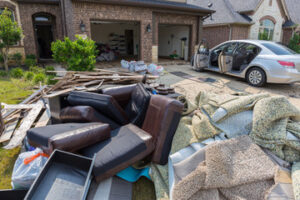How Water Damage Cleanup Works
Before you begin water damage cleanup, it’s important to get rid of any items that are soaked or ruined. Certain materials pose health risks, such as waterlogged drywall and insulation, so you should contact a professional for assistance. Junk removal services can help you get rid of water-damaged furniture and other materials safely. After all, you don’t want to be surrounded by mold spores. This article explains some of the basic steps involved in water damage cleanup.
 The first step of water damage cleanup is removing compromised structural elements and replacing them with new ones. If necessary, extra insulation may be installed to prevent future flooding. Additionally, porous building materials like carpeting and laminate flooring will need to be removed. In some cases, these items will need a second cleaning. Water damage cleanup may not be completed immediately, but it will help you avoid long-term damage and unnecessary expenses. Here’s how water damage cleanup works: Once the water damage cleanup team arrives, they’ll remove porous materials and replace them with new ones.
The first step of water damage cleanup is removing compromised structural elements and replacing them with new ones. If necessary, extra insulation may be installed to prevent future flooding. Additionally, porous building materials like carpeting and laminate flooring will need to be removed. In some cases, these items will need a second cleaning. Water damage cleanup may not be completed immediately, but it will help you avoid long-term damage and unnecessary expenses. Here’s how water damage cleanup works: Once the water damage cleanup team arrives, they’ll remove porous materials and replace them with new ones.
When dealing with water damage, it’s important to determine whether it is new or old. If the water is brand-new, you’ll have only one spot of dark water and no rings. Additionally, it will be firm but not soaked, because it hasn’t had time to weaken drywall. In this situation, a professional water damage cleanup company will charge $4.50 per square foot to remove the water and repair any structural damage.
If the water is clean, this step is less important. Standing water poses a health hazard as bacteria, mold, and fungi grow. Standing water can cause the drywall to bulge, wood floors to warp, and even metal surfaces to corrode and rust. Standing water may also pose a biohazard. This can cause health issues as well as significantly increase the cost of water damage cleanup. To prevent this, you should call a water damage cleanup company as soon as possible.
Another step in water damage cleanup is mold removal. Professional water damage cleanup companies are trained to detect hidden molds and treat them accordingly. Professional mold removal services will conduct proper testing to identify hidden mold, and they will wear protective gear and other safety equipment necessary to remove it. They will also have the tools and knowledge to safely remove the mold, so you can rest easy. You can call a water damage restoration company to clean up any mold-infested area.
If you have an insurance claim, it is essential to document all contents. Take pictures of the damage and document everything. Not all home insurance policies cover flood damage, so it’s vital to document the damage for your insurance claim. If you’re not certain whether your home insurance will cover the costs of flood clean-up, be sure to contact your insurance company as soon as possible. You should also keep your family safe, and get an evaluation of the damages to your home.
The cost of water damage cleanup depends on the type and size of the area affected. Category 2 water damage, for example, is caused by faulty backflows in plumbing fixtures and may even be discovered during a home inspection for another issue. Blackwater, on the other hand, is considered to be a hazardous and unsanitary substance and requires immediate remediation. It’s important to call a water damage clean-up service if you suspect you’ve had a flood.
Hiring a water damage cleanup service will minimize the overall cost of water damage clean-up, drying, and restoration. A water damage restoration company will also help mitigate future damages and repair the damage you’ve already sustained. By hiring a professional, you’ll save yourself a lot of hassle and money. And when you hire a water damage restoration company, you can be confident that the job will be done right the first time.
A local company that services homes and businesses in the area offers water damage clean-up services. Licensed technicians will assess the scope of water damage, identify hidden issues, and thoroughly dry the affected area. They’ll even identify and treat mold. And of course, they’ll also clean up all lingering bad odors from carpets. All of this means that you won’t have to deal with lingering smells, which can be very unpleasant for your health.
After water damage clean-up, you’ll need to dry the area as quickly as possible. This step is very important because bacteria will start growing in less than 24 hours. You’ll need a dehumidifier or fan to speed up the drying process. Then, disinfect the area with hot water and bleach. Dish soap and bleach are good options, as they’ll loosen up any accumulated grime. Be sure to leave the area clean for 30 minutes before cleaning with a vacuum.






